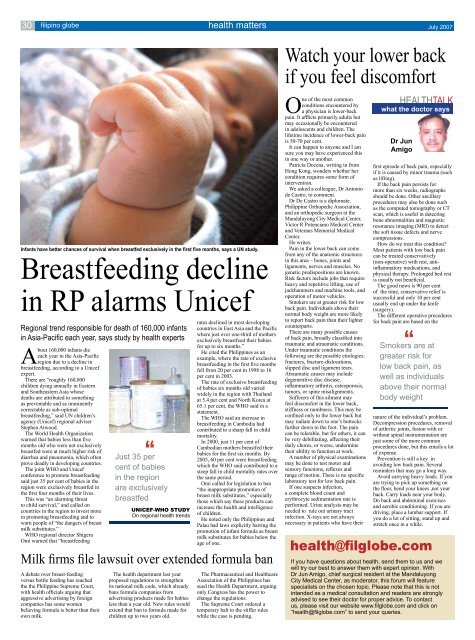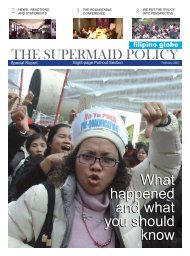filipino globe
MJ says thank you for all your kind help - filipino globe
MJ says thank you for all your kind help - filipino globe
You also want an ePaper? Increase the reach of your titles
YUMPU automatically turns print PDFs into web optimized ePapers that Google loves.
30<br />
<strong>filipino</strong> <strong>globe</strong> health matters<br />
July 2007<br />
lakbayan<br />
<strong>filipino</strong> <strong>globe</strong> February July 2007 31<br />
Infants have better chances of survival when breastfed exclusively in the first five months, says a UN study.<br />
Breastfeeding decline<br />
in RP alarms Unicef<br />
Regional trend responsible for death of 160,000 infants<br />
in Asia-Pacific each year, says study by health experts<br />
About 160,000 infants die<br />
each year in the Asia-Pacific<br />
region due to a decline in<br />
breastfeeding, according to a Unicef<br />
expert.<br />
There are “roughly 160,000<br />
children dying annually in Eastern<br />
and Southeastern Asia whose<br />
deaths are attributed to something<br />
as preventable and as imminently<br />
correctable as sub-optimal<br />
breastfeeding,” said UN children’s<br />
agency (Unicef) regional adviser<br />
Stephen Atwood.<br />
The World Health Organization<br />
warned that babies less than five<br />
months old who were not exclusively<br />
breastfed were at much higher risk of<br />
diarrhea and pneumonia, which often<br />
prove deadly in developing countries.<br />
The joint WHO and Unicef<br />
conference to promote breastfeeding<br />
said just 35 per cent of babies in the<br />
region were exclusively breastfed in<br />
the first four months of their lives.<br />
This was “an alarming threat<br />
to child survival,” and called on<br />
countries in the region to invest more<br />
in promoting breastfeeding and to<br />
warn people of “the dangers of breast<br />
milk substitutes.”<br />
WHO regional director Shigeru<br />
Omi warned that “breastfeeding<br />
“<br />
Just 35 per<br />
cent of babies<br />
in the region<br />
are exclusively<br />
breastfed<br />
UNICEF-WHO STUDY<br />
On regional health trends<br />
rates declined in most developing<br />
countries in East Asia and the Pacific<br />
where just over one-third of mothers<br />
exclusively breastfeed their babies<br />
for up to six months.”<br />
He cited the Philippines as an<br />
example, where the rate of exclusive<br />
breastfeeding in the first five months<br />
fell from 20 per cent in 1998 to 16<br />
per cent in 2003.<br />
The rate of exclusive breastfeeding<br />
of babies six months old varied<br />
widely in the region with Thailand<br />
at 5.4 per cent and North Korea at<br />
65.1 per cent, the WHO said in a<br />
statement.<br />
The WHO said an increase in<br />
breastfeeding in Cambodia had<br />
contributed to a sharp fall in child<br />
mortality.<br />
In 2000, just 11 per cent of<br />
Cambodian mothers breastfed their<br />
babies for the first six months. By<br />
2005, 60 per cent were breastfeeding<br />
which the WHO said contributed to a<br />
steep fall in child mortality rates over<br />
the same period.<br />
Omi called for legislation to ban<br />
“the inappropriate promotion of<br />
breast milk substitutes,” especially<br />
those which say these products can<br />
increase the health and intelligence<br />
of children.<br />
He noted only the Philippines and<br />
Palau had laws explicitly barring the<br />
promotion of infant formula as breast<br />
milk substitutes for babies below the<br />
age of one.<br />
Milk firms file lawsuit over extended formula ban<br />
A debate over breast-feeding<br />
versus bottle feeding has reached<br />
the the Philippine Supreme Court,<br />
with health officials arguing that<br />
aggressive advertising by foreign<br />
companies has some women<br />
believing formula is better than their<br />
own milk.<br />
The health department last year<br />
proposed regulations to strengthen<br />
its national milk code, which already<br />
bans formula companies from<br />
advertising products made for babies<br />
less than a year old. New rules would<br />
extend that ban to formula made for<br />
children up to two years old.<br />
The Pharmaceutical and Healthcare<br />
Association of the Philippines has<br />
sued the Health Department, arguing<br />
only Congress has the power to<br />
change the regulations.<br />
The Supreme Court ordered a<br />
temporary halt to the stiffer rules<br />
while the case is pending.<br />
Watch your lower back<br />
if you feel discomfort<br />
One of the most common<br />
conditions encountered by<br />
a physician is lower-back<br />
pain. It afflicts primarily adults but<br />
may occasionally be encountered<br />
in adolescents and children. The<br />
lifetime incidence of lower-back pain<br />
is 50-70 per cent.<br />
It can happen to anyone and I am<br />
sure you may have experienced this<br />
in one way or another.<br />
Patricia Docena, writing in from<br />
Hong Kong, wonders whether her<br />
condition requires some form of<br />
intervention.<br />
We asked a colleague, Dr Antonio<br />
de Castro, to comment.<br />
Dr De Castro is a diplomate,<br />
Philippine Orthopedic Association,<br />
and an orthopedic surgeon at the<br />
Mandaluyong City Medical Center,<br />
Victor R Potenciano Medical Center<br />
and Veterans Memorial Medical<br />
Center.<br />
He writes:<br />
Pain in the lower back can come<br />
from any of the anatomic structures<br />
in this area – bones, joints and<br />
ligaments, nerves and muscles. No<br />
genetic predispositions are known.<br />
Risk factors include jobs that require<br />
heavy and repetitive lifting, use of<br />
jackhammers and machine tools, and<br />
operation of motor vehicles.<br />
Smokers are at greater risk for low<br />
back pain. Individuals above their<br />
normal body weight are more likely<br />
to report back pain than their lighter<br />
counterparts.<br />
There are many possible causes<br />
of back pain, broadly classified into<br />
traumatic and atraumatic conditions.<br />
Under traumatic conditions the<br />
following are the possible etiologies:<br />
fractures, fracture-dislocations,<br />
slipped disc and ligament tears.<br />
Atraumatic causes may include<br />
degenerative disc disease,<br />
inflammatory arthritis, osteoporosis,<br />
tumors, or spine misalignments.<br />
Sufferers of this ailment may<br />
feel discomfort in the lower back,<br />
stiffness or numbness. This may be<br />
confined only to the lower back but<br />
may radiate down to one’s buttocks<br />
further down to the foot. The pain<br />
can be tolerable, but for others, it can<br />
be very debilitating, affecting their<br />
daily chores, or worse, undermine<br />
their ability to function at work.<br />
A number of physical examinations<br />
may be done to test motor and<br />
sensory functions, reflexes and<br />
range of motion. There is no specific<br />
laboratory test for low back pain.<br />
If one suspects infection,<br />
a complete blood count and<br />
erythrocyte sedimentation rate is<br />
performed. Urine analysis may be<br />
needed to rule out urinary tract<br />
infection. X-rays are not always<br />
necessary in patients who have their<br />
HEALTHTALK<br />
what the doctor says<br />
Dr Jun<br />
Amigo<br />
first episode of back pain, especially<br />
if it is caused by minor trauma (such<br />
as lifting).<br />
If the back pain persists for<br />
more than six weeks, radiographs<br />
should be done. Other ancillary<br />
procedures may also be done such<br />
as the computed tomography or CT<br />
scan, which is useful in detecting<br />
bone abnormalities and magnetic<br />
resonance imaging (MRI) to detect<br />
the soft tissue defects and nerve<br />
compressions.<br />
How do we treat this condition?<br />
Most patients with low back pain<br />
can be treated conservatively<br />
(non-operative) with rest, antiinflammatory<br />
medications, and<br />
physical therapy. Prolonged bed rest<br />
is usually not beneficial.<br />
The good news is 90 per cent<br />
of the time, conservative relief is<br />
successful and only 10 per cent<br />
usually end up under the knife<br />
(surgery).<br />
The different operative procedures<br />
for back pain are based on the<br />
“ Smokers are at<br />
greater risk for<br />
low back pain, as<br />
well as individuals<br />
above their normal<br />
body weight<br />
nature of the individual’s problem.<br />
Decompression procedures, removal<br />
of arthritic joints, fusion with or<br />
without spinal instrumentation are<br />
just some of the more common<br />
procedures done, but this entails a lot<br />
of expense.<br />
Prevention is still a key in<br />
avoiding low back pain. Several<br />
reminders that may go a long way.<br />
Avoid carrying heavy loads. If you<br />
are trying to pick up something on<br />
the floor, bend your knees ,not your<br />
back. Carry loads near your body.<br />
Do back and abdominal exercises<br />
and aerobic conditioning. If you are<br />
driving, place a lumbar support. If<br />
you do a lot of sitting, stand up and<br />
stretch once in a while.<br />
health@fil<strong>globe</strong>.com<br />
If you have questions about health, send them to us and we<br />
will try our best to answer them with expert opinion. With<br />
Dr Jun Amigo, chief surgical resident at the Mandaluyong<br />
City Medical Center, as moderator, this forum will feature<br />
specialists on the chosen topic. Please note that this is not<br />
intended as a medical consultation and readers are strongly<br />
advised to see their doctor for proper advice. To contact<br />
us, please visit our website www.fil<strong>globe</strong>.com and click on<br />
“health@fil<strong>globe</strong>.com” to send your queries.<br />
You enter the island through a concrete jetty (above) and hop on a tram bus (below) for a quick tour. The massive guns fell silent more than 50 years ago, but images of the war remain<br />
fresh in the memory, such as the Malinta Tunnel and a Spanish lighthouse (below, right), which survived the bombings. A high-speed catamaran (bottom) will take you to Corregidor.<br />
Peace was won on this little island<br />
More than a tourist<br />
attraction, Corregidor is<br />
a revered piece of our<br />
national history, writes<br />
Gilda Medina Bernal<br />
The voices of about 15 Filipino<br />
high school students went up<br />
several decibels while they<br />
scampered for their seats on the front<br />
row of the Sun Cruise catamaran. A<br />
few minutes later, several Japanese<br />
men in their 60s quietly settled<br />
comfortably in one corner.<br />
Three American men shortly<br />
followed. Wearing jersey shirts and<br />
hunting huts, they were bragging<br />
about their travels in Asia.<br />
A female voice on the PA system<br />
announcing the tour’s guidelines was<br />
engulfed by the frenetic mood inside<br />
the ship, along with shrieks from<br />
kids running around.<br />
It was a warm Sunday morning, a<br />
perfect day for a cruise, and a history<br />
tour. At exactly 8:15, the ship started<br />
to sail slowly towards its destination<br />
– Corregidor Island. It was a onehour<br />
journey and the tourists were all<br />
probably thinking of the same thing<br />
– what’s on this island?<br />
“It’s a rock and a fun place,” says<br />
a travel program shown on television<br />
during the trip. But according to<br />
historians, this solitary piece of rock<br />
shaped like a tadpole is more than<br />
just that.<br />
The island lies between Cavite<br />
and Bataan, with a land area of<br />
only nine square kilometers. It is<br />
known by many as the place where<br />
General Douglas MacArthur was<br />
stationed during World War II. It<br />
was a key military defense station<br />
of the Allied Forces. But not too<br />
many knew it also became the seat<br />
of the Philippine Commonwealth<br />
government under President Manuel<br />
Quezon. This was also where<br />
General Jonathan Wainwright<br />
surrendered the entire Philippines to<br />
the Japanese invaders in May 1942.<br />
Before this, MacArthur was pulled<br />
out of Corregidor and travelled to<br />
Australia where he vowed to return<br />
to the Philippines.<br />
Corregidor was ravaged by the<br />
Japanese, earning its place on the<br />
map as one of the most bombed<br />
fortresses in the world in proportion<br />
to its size. “Corregidor Island was at<br />
the center of the war,” says Richard<br />
Andrada, a tour guide.<br />
“When the Japanese were starting<br />
to fortify the island, they did not<br />
realise that the Allied Forces were<br />
also getting ready to recapture<br />
Corregidor, bringing back its glory as<br />
a bastion of defense”.<br />
MacArthur returned to the<br />
Philippines following the recapture<br />
of Corregidor in March 1945.<br />
The war has long been over.<br />
MacArthur and Quezon are long<br />
gone but their statues stand on the<br />
island, and memories of the war<br />
remain.<br />
After more than 50 years,<br />
“ After more than 50<br />
years, Corregidor<br />
the defense shield<br />
is now an island of<br />
tranquility<br />
Corregidor the defense shield is<br />
now an island of tranquility. It is<br />
populated by only 200 people, who<br />
work as guides and employees of<br />
tour groups.<br />
“It is very peaceful on the island.<br />
Thousands of lives were taken here<br />
– Filipinos, Americans and Japanese<br />
– and we remember them everytime<br />
we pass by the ruins, by the roads,<br />
and by the foxholes that have became<br />
witness to the war,” Andrada adds as<br />
our tram bus passed by a pit where<br />
more than 200 bodies of Japanese<br />
were found after the war.<br />
The Japanese, believing that to<br />
surrender was an act of disgrace,<br />
performed a ritual suicide by striking<br />
their stomach with a sword or<br />
bayonet. Some would use grenades<br />
or jump from a cliff.<br />
Suddenly the frenzied mood of the<br />
tourists turned somber. The feeling<br />
of being surrounded by the souls of<br />
the soldiers killed in battle was eerie.<br />
We moved on to the next landmark<br />
and reached the massive guns of<br />
Corregidor.<br />
“We’ve been asking people to<br />
take one of the barrels as a souvenir<br />
but there are no takers,” Andrada<br />
jokes of the mortar guns in front of<br />
us. Several batteries, consisting of<br />
mortar guns and ammunition, were<br />
set up during the war. The barrel<br />
length of one rifle was about 10 feet<br />
and at least 14 men were needed to<br />
maneuver the entire gun.<br />
Just looking at the weaponry was<br />
enough for tourists to stand still,<br />
perhaps wondering how these guns<br />
became instrumental in bringing<br />
down the enemy.<br />
The tourists were as silent as<br />
the guns, which will not see the<br />
destruction of another war ever<br />
again.<br />
As we ended our tour of the<br />
island, it was apparent that there<br />
was more to Philippine history than<br />
what we learned in textbooks. For<br />
the Japanese and the Americans,<br />
Corregidor was as much a part of<br />
their history as ours.<br />
War was fought and peace was<br />
won on Corregidor Island and<br />
because of that, it has remained a<br />
formidable piece of rock.






